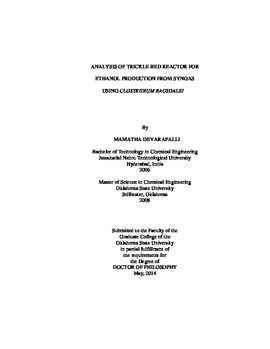| dc.contributor.advisor | Atiyeh, Hasan K. | |
| dc.contributor.author | Devarapalli, Mamatha | |
| dc.date.accessioned | 2017-02-22T22:12:10Z | |
| dc.date.available | 2017-02-22T22:12:10Z | |
| dc.date.issued | 2014-05 | |
| dc.identifier.uri | https://hdl.handle.net/11244/48955 | |
| dc.description.abstract | The conversion of syngas components (CO, CO2 and H2) to liquid fuels such as ethanol involves complex biochemical reactions catalyzed by a group of acetogens such as Clostridium ljungdahlii, Clostridium carboxidivorans and Clostridium ragsdalei. The low ethanol productivity in this process is associated with the low solubility of gaseous substrates CO and H2 in the fermentation medium. In the present study, a 1-L trickle-bed reactor (TBR) was analyzed to understand its capabilities to improve the mass transfer of syngas in fermentation medium. Further, semi-continuous and continuous syngas fermentations were performed using C. ragsdalei to evaluate the ability of the TBR for ethanol production. In the mass transfer studies, using 6-mm glass beads, it was found that the overall mass transfer coefficient (kLa/VL) increased with the increase in gas flow rate from 5.5 to 130.5 sccm. Further, an increase in the liquid flow rate in the TBR decreased the kLa/VL due to the increase in liquid hold up volume (VL) in the packing. The highest kLa/VL values of 421 h-1 and 178 h-1 were achieved at a gas flow rate of 130.5 sccm for 6-mm and 3-mm glass beads, respectively. Semi-continuous fermentations were performed with repetitive medium replacement in counter-current and co-current modes. In semi-continuous fermentations with syngas consisting of 38% CO, 5% N2, 28.5% CO2 and 28.5% H2 (by volume), the increase in H2 conversion (from 18 to 55%) and uptake (from 0.7 to 2.2 mmol/h) were observed. This increase was attributed to more cell attachment in the packing that reduced CO inhibition to hydrogenase along the column length and increased the H2 uptake. The maximum ethanol produced during counter-current and co-current modes were 3.0 g/L and 5.7 g/L, respectively. In continuous syngas fermentation, the TBR was operated at dilution rates between 0.006 h-1and 0.012 h-1 and gas flow rates between 1.5 sccm and 18.9 sccm. The highest ethanol concentration of 13 g/L was achieved at dilution and gas flow rates of 0.012 h-1 and 18.9 sccm, respectively. The molar ratio of ethanol to acetic acid of 4:1 was obtained during continuous fermentation which was 7.7 times higher than in semi-continuous fermentations. The improvement of the reactor performance in continuous mode gives scope to explore the TBR as a potential bioreactor design for large scale biofuels production. | |
| dc.format | application/pdf | |
| dc.language | en_US | |
| dc.rights | Copyright is held by the author who has granted the Oklahoma State University Library the non-exclusive right to share this material in its institutional repository. Contact Digital Library Services at lib-dls@okstate.edu or 405-744-9161 for the permission policy on the use, reproduction or distribution of this material. | |
| dc.title | Analysis of trickle-bed reactor for ethanol production from syngas using Clostridium ragsdalei | |
| dc.contributor.committeeMember | Huhnke, Raymond L. | |
| dc.contributor.committeeMember | Ramsey, Joshua D. | |
| dc.contributor.committeeMember | Wilkins, Mark R. | |
| osu.filename | Devarapalli_okstate_0664D_13347.pdf | |
| osu.accesstype | Open Access | |
| dc.type.genre | Dissertation | |
| dc.type.material | Text | |
| thesis.degree.discipline | Biosystems and Agricultural Engineering | |
| thesis.degree.grantor | Oklahoma State University | |
